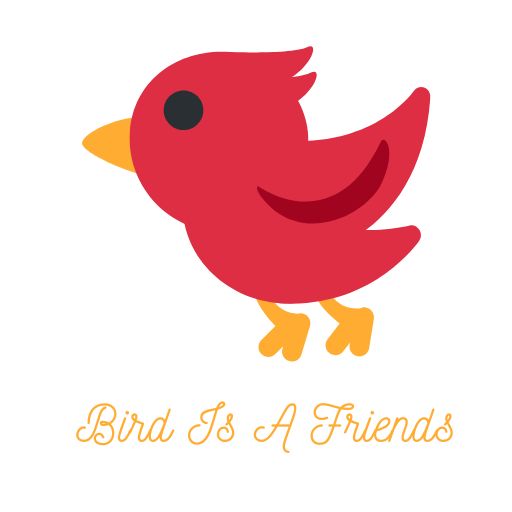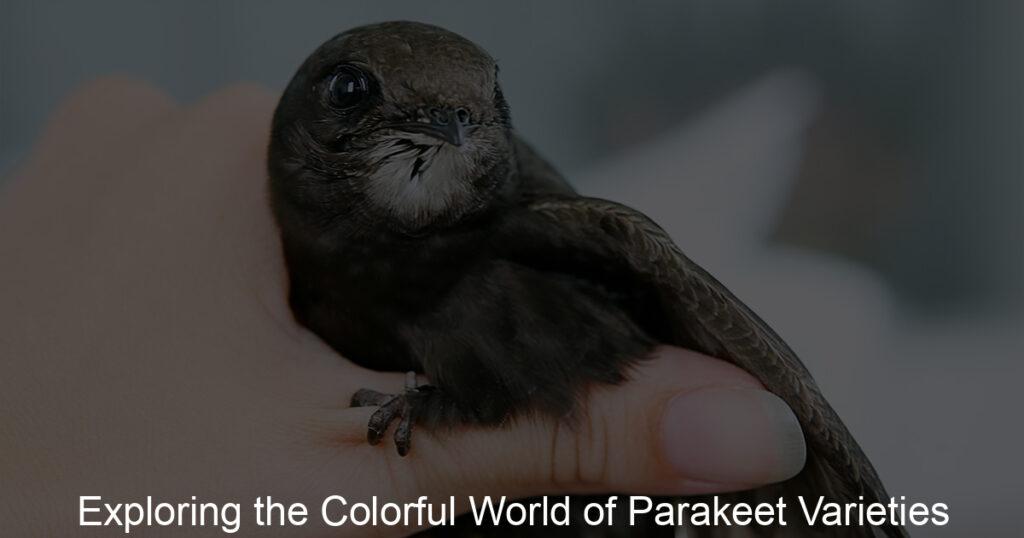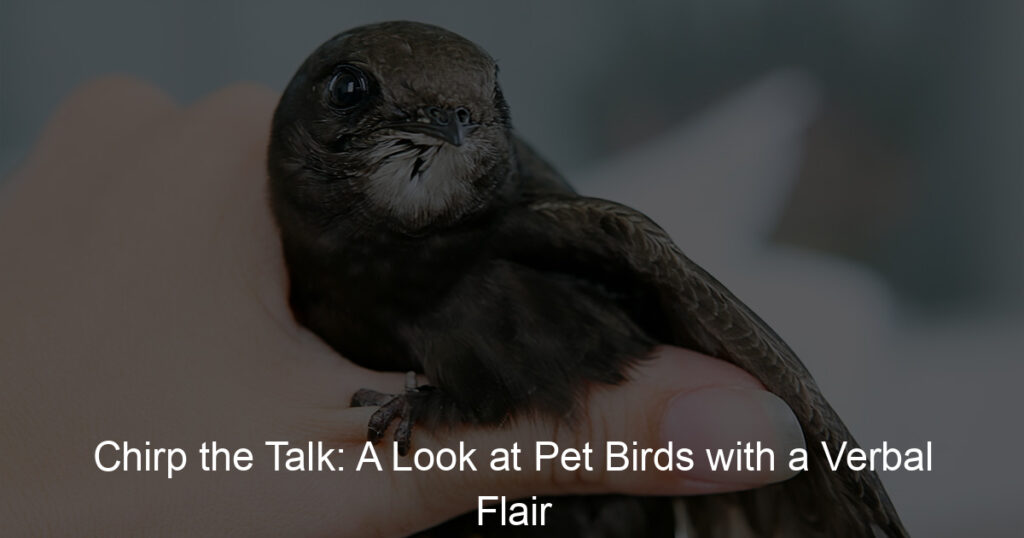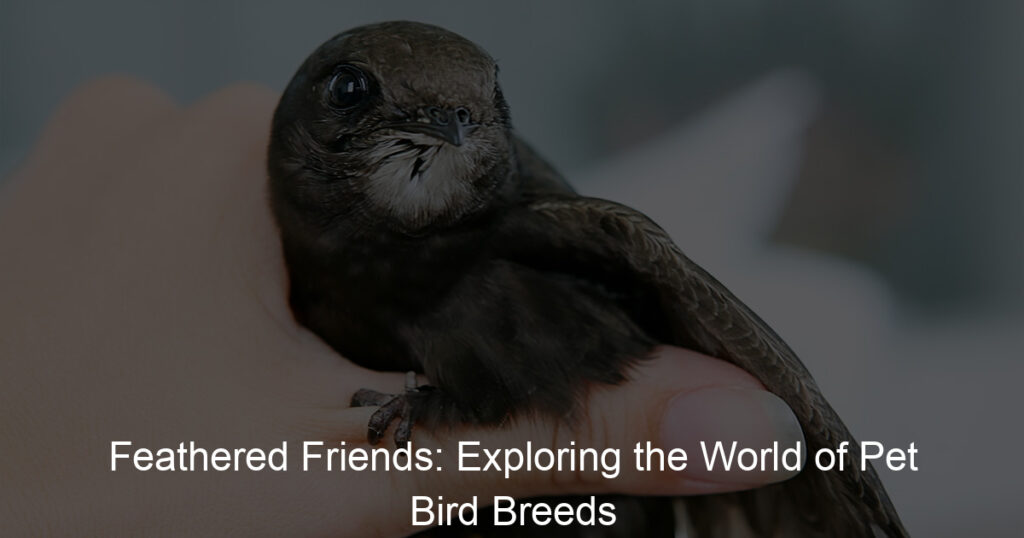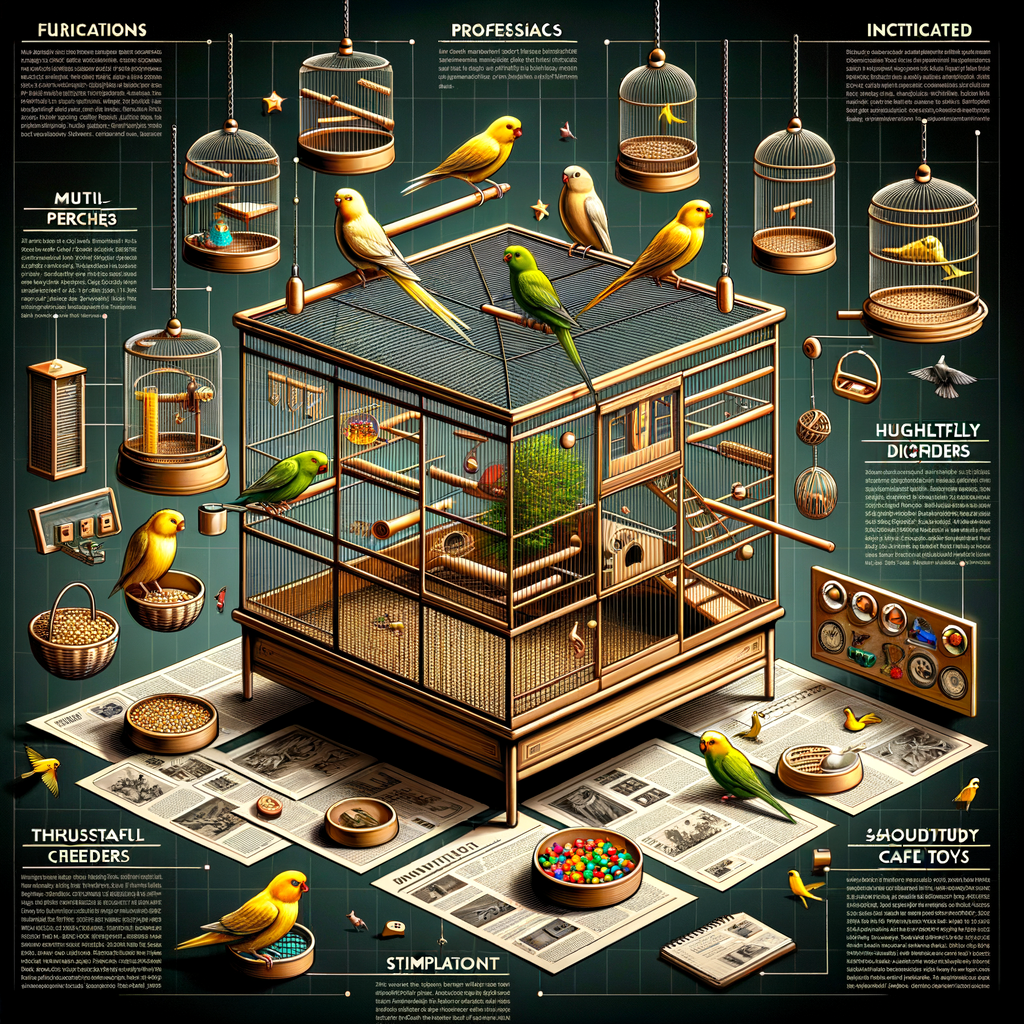
Introduction to Canary Cage Setup
Canaries are delightful birds known for their vibrant colors and melodious songs. They are also known for their need for a specific environment to thrive. That’s why setting up a canary cage properly is essential. In this post, we will guide you through the importance of a proper canary cage setup and help you understand the basics of canary cage requirements.
- Importance of a Proper Canary Cage Setup
- Understanding the Basics of Canary Cage Requirements
A proper canary cage setup is not just about aesthetics, it’s about creating a safe and comfortable environment for your pet. A well-set cage can help your canary feel secure, which in turn can improve its overall health and happiness. It can also prevent accidents and injuries, and make it easier for you to clean and maintain the cage. Remember, a happy canary is a singing canary!
When it comes to the basics of canary cage requirements, there are a few key things to keep in mind. First, the cage should be spacious enough for your canary to fly and move around comfortably. Second, it should have proper ventilation to ensure fresh air circulation. Third, it should be made of safe, non-toxic materials. Fourth, it should have a secure door to prevent your canary from escaping. Lastly, it should include essential accessories like perches, food and water dishes, and toys to keep your canary entertained.
In the following sections, we will delve deeper into the essentials for a canary cage, how to design the interior of the cage, the different accessories you can add, and how to maintain the cage. By the end of this post, you will be well-equipped to create the perfect canary cage for your feathered friend.
Essentials for Canary Cage
When it comes to creating a comfortable and safe environment for your canary, the cage plays a crucial role. It’s not just about picking a cage, it’s about choosing the right one. Here are some key factors to consider:
Choosing the Right Cage
There are several aspects to consider when choosing a cage for your canary. Let’s break them down:
- Size and Shape
- Material and Construction
- Accessibility and Cleaning
The size of the cage is crucial for your canary’s comfort and health. Canaries love to fly, so the cage should be wide enough to allow them to do so. The ideal cage size is at least 24 inches wide, 24 inches deep, and 24 inches high. As for the shape, opt for a rectangular or square cage. Round cages can make canaries feel insecure as they don’t have corners to hide in.
Canary cages should be made of safe, non-toxic materials. Stainless steel is a good choice as it’s durable and easy to clean. The bars should be spaced no more than 1/2 inch apart to prevent your canary from getting its head stuck. Also, make sure the cage has a solid base to hold the bird’s food and water dishes.
Choose a cage that has large doors for easy access. This will make it easier for you to feed your canary and clean the cage. The cage should also have a removable bottom tray for easy cleaning. Remember, a clean cage is essential for your canary’s health.
In conclusion, choosing the right cage is a crucial step in creating a comfortable and safe environment for your canary. Remember, the cage is your bird’s home, so it should be spacious, secure, and easy to clean.
Location and Environment
When setting up your canary cage, two vital factors to consider are the location and the environment. These elements play a significant role in the health and happiness of your canary.
- Choosing the Ideal Location
- Understanding the Importance of Light and Temperature
Choosing the right location for your canary cage is crucial. Canaries are social creatures and enjoy being in areas where they can see and hear the family. A living room or family room is often a good choice. However, avoid placing the cage in the kitchen due to potential exposure to harmful fumes from cooking or cleaning products.
Also, avoid placing the cage near windows or doors where drafts could make your canary uncomfortable. A location that allows for a balance of social interaction, natural light, and safety is ideal.
Light and temperature are also significant factors in the well-being of your canary. Canaries need a good amount of natural light each day. However, direct sunlight can cause the cage to become too hot. Therefore, it’s essential to place the cage in a location that gets indirect sunlight.
Temperature-wise, canaries are comfortable in a room that’s between 60 and 70 degrees Fahrenheit. Sudden changes in temperature can be harmful, so try to keep the room temperature consistent.
In conclusion, the location and environment of your canary cage can greatly affect your bird’s health and happiness. By carefully considering these factors when setting up your cage, you can create a comfortable and stimulating environment for your canary.
Setting Up Bird Cage: Interior Design
When it comes to setting up your bird cage, the interior design plays a crucial role. It not only enhances the aesthetic appeal of the cage but also provides a comfortable and stimulating environment for your bird. One of the key elements in the interior design of a bird cage is the arrangement of perches and swings.
Perches and Swings
Perches and swings are essential for your bird’s physical and mental well-being. They provide a place for your bird to rest, play, and exercise. Let’s delve into the types of perches and their placement in the cage.
- Types of Perches
- Wooden Perches: These are the most common type of perches. They are durable, easy to clean, and provide a natural feel for the bird.
- Rope Perches: These are soft and flexible, making them comfortable for the bird’s feet. However, they can be harder to clean.
- Plastic Perches: These are easy to clean and durable, but they lack the natural feel of wooden perches.
- Placement of Perches and Swings
- Place perches at different heights in the cage to encourage climbing and exploration.
- Ensure that perches and swings are not placed directly above food and water dishes to prevent contamination.
- Leave enough space between perches and the cage walls to allow the bird to comfortably move around.
There are several types of perches available in the market, each with its own benefits. Here are a few common types:
The placement of perches and swings in the bird cage is just as important as the type of perch. Here are a few tips for perch placement:
In conclusion, the interior design of a bird cage, particularly the arrangement of perches and swings, plays a vital role in ensuring your bird’s happiness and health. By choosing the right types of perches and placing them strategically in the cage, you can create a stimulating and comfortable environment for your feathered friend.
Feeding and Watering Accessories
When setting up your canary cage, it’s important to consider the feeding and watering accessories. These are essential for your bird’s health and well-being. Let’s take a closer look at how to choose the right ones and where to place them in the cage.
- Choosing the Right Feeders and Water Containers
- Placement of Feeders and Water Containers
Choosing the right feeders and water containers is crucial for your canary’s health. Canaries need a balanced diet of seeds, fruits, and vegetables. Therefore, you should choose feeders that can accommodate these different types of food.
For water, a simple, easy-to-clean container that your canary can easily access is the best choice. It should be sturdy enough to not tip over and large enough to provide your bird with enough water throughout the day.
Remember, the material of the feeders and water containers is also important. Plastic is a common choice due to its durability and ease of cleaning. However, make sure it’s BPA-free to ensure it’s safe for your bird.
Placement of feeders and water containers in the cage is just as important as choosing the right ones. They should be placed at a height that is comfortable for your canary to reach but not so low that they can easily be soiled.
It’s also a good idea to place them near a perch so your canary can easily access them. However, avoid placing them directly under perches to prevent droppings from contaminating the food or water.
Lastly, remember to place the water container away from the feeder to prevent food particles from getting into the water.
| Feeder and Water Container Considerations | Details |
|---|---|
| Type of Food | Seeds, fruits, and vegetables |
| Material | BPA-free plastic |
| Placement | Comfortable height, near a perch, away from droppings |
In conclusion, choosing the right feeders and water containers and placing them correctly in the cage is crucial for your canary’s health and well-being. By following these tips, you can ensure your bird has a safe and comfortable environment to thrive in.
Canary Cage Accessories: Toys and More
When it comes to creating a happy and healthy environment for your canary, the accessories you choose to put in their cage can make all the difference. Let’s explore some of the best toys and accessories for your feathered friend.
-
Choosing the Right Toys
Canaries are active and intelligent birds, and they need toys to keep them entertained and mentally stimulated. But not all toys are created equal. Here are a few things to keep in mind:
- Safety: Avoid toys with small parts that can be swallowed or sharp edges that can cause injury.
- Size: The toy should be appropriate for the size of your canary. It should be large enough to be engaging, but not so large that it overwhelms your bird or takes up too much space in the cage.
- Variety: Canaries enjoy a range of different activities, so provide a mix of toys that allow for climbing, chewing, and puzzle-solving.
Examples of good toys for canaries include ladders, swings, bells, and puzzle toys. Remember to rotate the toys regularly to keep your canary’s environment interesting and stimulating.
-
Mirrors and Other Accessories
Canaries are social creatures, and a mirror can provide a sense of companionship, especially if your canary is the only bird in the cage. However, it’s important to monitor your bird’s behavior with the mirror. Some canaries may become obsessed with their reflection, which can lead to stress and unhealthy behaviors.
Other useful accessories for your canary’s cage include:
- Perches: Canaries need a variety of perches at different heights and thicknesses to help exercise their feet and prevent arthritis.
- Bathing dish: Canaries love to bathe, so provide a shallow dish with fresh water for this purpose.
- Food and water dishes: These should be easy to clean and refill, and positioned at a comfortable height for your bird.
Remember, the goal is to create a cage environment that is safe, comfortable, and stimulating for your canary. With the right toys and accessories, you can ensure your feathered friend stays happy and healthy.
Canary Cage Maintenance
Maintaining your canary’s cage is crucial for their health and happiness. This involves regular cleaning and sanitizing to keep the cage environment safe and comfortable for your bird.
Cleaning and Sanitizing
Keeping your canary’s cage clean and sanitized not only ensures a pleasant environment for your bird but also helps prevent the spread of diseases. Here are two key steps to follow:
- Regular Cleaning Schedule
- Deep Cleaning and Sanitizing
It’s important to establish a regular cleaning schedule for your canary’s cage. This includes daily tasks such as removing food and water dishes for cleaning, sweeping out old seeds and droppings, and wiping down perches and toys. A clean cage will help your canary stay healthy and happy.
Along with daily cleaning, a deep clean and sanitization of the cage should be done every month. This involves taking everything out of the cage, washing it with a bird-safe disinfectant, and thoroughly rinsing before drying. This deep cleaning eliminates any harmful bacteria or parasites that may be lurking in the cage.
Remember, a clean cage is a happy cage. By maintaining a regular cleaning schedule and performing deep cleans, you can ensure your canary has a safe and comfortable home.
Monitoring Health Through Cage Maintenance
Keeping a close eye on your canary’s cage can provide valuable clues about their health. A clean and well-maintained cage not only ensures a happy and comfortable environment for your bird but also helps you to detect any signs of illness early. Let’s explore some key signs to look out for and when it might be time to seek veterinary care.
- Signs of Illness in Canaries
- Change in Activity Levels: If your canary is less active than usual, or spends a lot of time at the bottom of the cage, it could be a sign of illness.
- Appearance: Look for changes in feather condition, weight loss, or unusual posture.
- Droppings: Changes in the color, consistency, or quantity of droppings can indicate a health issue.
- When to Seek Veterinary Care
Canaries are good at hiding their illness, so it’s important to know what to look for. Changes in their behavior, appearance, or droppings can all be signs of potential health problems. Here are some things to watch out for:
If you notice any of the above signs, or if your canary seems unwell in any other way, it’s important to seek veterinary care as soon as possible. Canaries can become seriously ill very quickly, so don’t delay in getting help. Remember, it’s always better to be safe than sorry when it comes to your bird’s health.
In conclusion, monitoring your canary’s cage and being aware of the signs of illness can help ensure your bird stays healthy and happy. Regular cage maintenance is not just about cleanliness, it’s also a crucial part of your bird’s healthcare routine.
Conclusion: Creating the Perfect Canary Cage
As we reach the end of our comprehensive guide, it’s time to recap everything we’ve learned and share some final thoughts on creating a canary paradise. Remember, the key to a happy and healthy canary is a well-set-up and maintained cage.
- Recap of Canary Cage Setup Guide
We started our journey by introducing the essentials of a canary cage. We learned that the cage should be spacious, with a rectangular shape being the most suitable. The cage should be placed in a quiet, well-lit area, away from drafts and direct sunlight.
Next, we delved into the interior design of the cage. We discussed the importance of perches and their placement, and the need for a variety of materials and diameters to keep your canary’s feet healthy. We also talked about the necessity of food and water dishes, and the benefits of having a bird bath.
We then explored the world of canary cage accessories, highlighting the importance of toys for mental stimulation and exercise. We also emphasized the need for regular rotation of these toys to keep your canary interested and engaged.
Lastly, we covered the critical aspect of cage maintenance. We stressed the importance of daily cleaning of food and water dishes, weekly cleaning of the cage floor, and monthly deep cleaning of the entire cage. We also discussed the need for regular health checks for your canary.
- Final Thoughts on Creating a Canary Paradise
Creating the perfect canary cage is about more than just providing a place for your bird to live. It’s about creating a safe, comfortable, and stimulating environment that caters to all your canary’s needs. It’s about ensuring your bird’s health and happiness. And it’s about forming a bond with your canary that is built on trust and mutual respect.
Remember, every canary is unique, and what works for one might not work for another. So, always observe your bird and adjust the cage setup as needed. With patience, love, and the right environment, your canary will thrive and fill your home with beautiful songs.
Thank you for joining us on this journey. We hope this guide has been informative and helpful in setting up your perfect canary cage. Happy bird-keeping!
